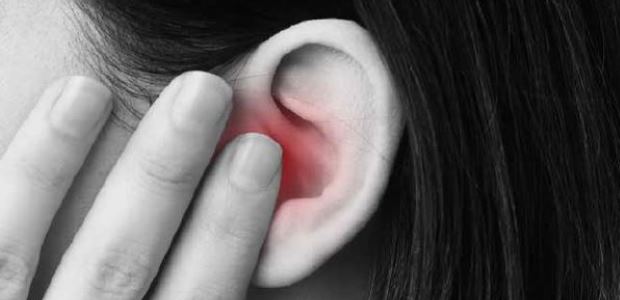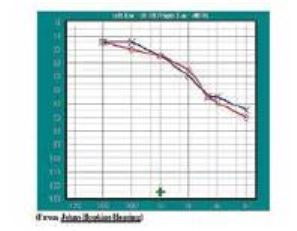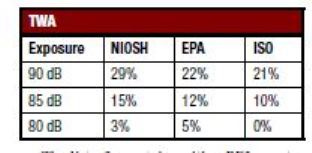
Is 85/3 In the Cards?
An overwhelming body of documented evidence suggests that the current PEL should be lowered to 85 dBA and the exchange rate be lowered to 3 dB.
In a 1996 report, NIOSH stated, "Today, no legitimate reason exists for any worker to incur an occupational hearing loss." What follows is a review of information that documents the progress, or lack thereof, toward preventing work-related hearing loss.
It is estimated that approximately 30 million U.S. workers are exposed to hazardous levels of noise on the job. The OSHA 8-hour time-weighted average (TWA) Permissible Exposure Limit is 90 decibels (dB), with a doubling rate (currently referred to as the "Exchange Rate") of 5 decibels. The exchange rate represents a mandatory halving of safe exposure time for every 5 dB of time-weighted average noise exposure above 90 dB. The goal of exposure limits is to reduce the risk of developing permanent hearing loss as a result of occupational noise exposure.
Even with an OSHA Hearing Conservation Standard in place, there are more than 20,000 private industry worker hearing loss incidents each year, representing approximately 12 percent of all non-fatal injuries/illnesses.1
The Hearing Process Simplified
Sound is characterized by intensity (decibels) and frequency (Hertz, or Hz). The normal range of hearing is 500 to 8000 Hz. Unwanted sound is called noise. However, many everyday sounds that we may not call noise, if of high enough intensity, can cause hearing damage.
As sound waves enter the outer ear, they strike the eardrum. The eardrum then generates mechanical vibrations in a fluid within the inner ear. Hair cells within the inner ear respond to the vibrations and convert the mechanical energy into electrical impulses that the brain interprets as sound. A variety of hair cells respond to different sound frequencies. High noise levels can damage the hair cells. While the hair cells can bounce back when sound exposure is interrupted, long enough or loud enough noise exposure will permanently damage them, resulting in selective hearing loss. Those closest to the middle ear are the higher frequency receptors. When exposed to high noise levels, these are the first to be damaged.
Hearing loss is cumulative. Over time, enough receptor hair cells can be damaged by high noise exposure, leading to permanent hearing loss that is called a Threshold Shift. Constant exposure to noise levels above 85 dB can cause hearing loss over time. Exposure to noise levels above 140 dB may cause acute permanent hearing loss.
What is dBA?
This is a logarithmic scale reading on a sound level meter that approximates the human ear’s response to moderate-level sounds in the 1000-4000 Hz range. Noise level monitoring is carried out with sound level meters or noise dosimeters.
It should be kept in mind that noise-related hearing loss is not limited to the workplace. There are plenty of non-work-related exposures that can cause hearing loss. They include a variety of leisure-time activities with sound levels above 90 dB, such as:
- Loud music
- Subways
- Motorcycles
- Construction sites
- Gun shots
- Rock concerts
- Lawn mowers/edgers
- Car audio systems
- NASCAR events
- Circular saws
- Snow throwers
- Snowmobiles
- Chain saws
- Boat motors
Hearing Conservation Programs
Hearing conservation programs are designed to protect the hearing of employees exposed to on-the-job noise. According to NIOSH,2 "The most common protection goal is the preservation of hearing for speech discrimination."
OSHA regulation 29 CFR 1910.95(c) stipulates the following components of a hearing conservation program:
- Employees exposed to a time-weighted average exposure of 85 dB or higher must be included in a Hearing Conservation Program.
- The program must be in writing.
- Area sound level monitoring is conducted to identify areas of concern.
- Participants in the program must undergo audiometric testing within six months of initial exposure (to serve as a baseline) and annually thereafter. (This period can be extended to a year if audiometric testing is conducted by a mobile hearing service.)
- Program participants must be provided annual training in hearing conservation, to include: 1) What types of hearing protection devices (HPDs) are available,
2) Their right to choose whatever device they prefer, 3) Training in proper usage of hearing protection devices,
- Mandatory wearing of HPDs for employees exposed to a TWA at or above 90 dBA.
- Mandatory wearing of HPDs for employees with a documented hearing loss.
What is a Threshold Shift?
A hearing test determines how loud sounds of different frequencies must be to be detected by the individual being tested. Signals of varying intensities and frequencies are randomly sent to a set of earphones worn by the person undergoing the test. When a signal is detected, the individual presses a button and the feedback is plotted on a chart of intensity versus frequency.
A typical chart looks like this, which shows increasing hearing loss in the higher frequencies:

Once an initial (baseline) chart has been generated, subsequent charts are compared to the baseline chart. As the person being tested ages, the baseline is corrected to account for normal aging hearing loss. If the current readings are higher than the baseline, this reflects a hearing loss, which can result not only from exposure to noise, but also from medical conditions or injuries. An average increase in intensity of 10 dB or more from the baseline in either ear over the range of prescribed test frequencies is called a Standard Threshold Shift (STS). If the increase is 25 dB or more and the increase is determined by a hearing specialist to be work-related, the finding is an OSHA recordable event. It is standard procedure to retest within 30 days any identified hearing loss, as some hearing losses can be temporary, with hearing recoverable when exposure is stopped. This is called a Temporary Threshold Shift (TTS).
Some Erroneous Assumptions
- A Temporary Threshold Shift as a predictor of permanent hearing loss has not been validated.
- All exposures that produce a given TTS will be equally hazardous.
- Sound levels during reduced noise exposure will be low enough to permit full recovery from TTS. "Effective Quiet" is the maximum sound level during quiet periods that will prevent any threshold shift in hearing.3 65 dB in 2000 and 4000-Hz ranges. 70 dB for 500 and 1000-Hz ranges.
Hearing Protection
As with any hazard, the most effective approaches to noise hazard abatement are engineering controls, such as:
- Elimination or replacement of noise-generating processes
- A "Buy Quiet" Policy, whereby new equipment is evaluated for noise levels prior to purchase
- Installing soundproofing panels and barriers
- Isolation of noise-generating processes with enclosures
- Reduction of noise levels on current operations, including equipment maintenance to reduce machine wear; shock mounts to reduce vibration; and minimizing of sound reflection
Administrative controls minimize the time in high-noise areas via work rotation, in addition to the availability of quiet areas to provide periodic relief.
Hearing protection devices (HPDs) should be used only if engineering and administrative controls don’t reduce average noise exposure below 85 dB. These devices include ear plugs, canal caps, ear muffs, and noise-canceling devices. Each of these has a Noise Reduction Rating (NRR), which is the number of decibels that a device can theoretically reduce ambient sound levels entering the ear. The NRR ratings are determined under ideal laboratory conditions. Actual NRR depends on how well the device is worn.
To account for the fact that HPDs may not provide the full NRR if worn incorrectly, a number of recommendations should be kept in mind. NIOSH recommends derating HPDs as follows:
- Ear muffs – NRR less 25 percent
- Formable ear plugs – NRR less 50 percent
- All other plugs – NRR less 70 percent
OSHA (in 29 CFR 1910.95 Appendix B) recommends derating as follows:
- A-weighted TWA minus (NRR less 7)/2.
For simplicity, a 1983 OSHA directive to Compliance Officers recommended derating all NRRs by 50 percent.
EPA is expected to announce a proposed new regulation for the labeling of HPDs. The new NRRs can be applied directly to dBA noise measurements without applying any corrections.
The Psychology of Hearing Protection
Where relatively few workers are exposed to high noise levels, the use of HPDs is not as consistent as in companies where a large proportion of the workforce is exposed. Workers with higher noise exposures are more likely to wear HPDs regularly, and companies with more noise-exposed workers are likely to have hearing conservation programs that are more complete.
Based on 22 reported worldwide studies, Berger, et al.4 made the following observations about hearing protection devices:
- "If only hearing protection devices were worn properly and consistently, such cases of (occupational noise-induced) hearing loss would cease to exist."
- "Today's typical, or, even above-average hearing conservation programs are ineffective in fully motivating and training employees to consistently and properly wear their HPDs."
- "There is divergence between values measured in the laboratory under ideal conditions and those values observed in the real world."
- Field attenuation values are low enough that in many actual environments even when only 10 dB of attenuation is required, it is questionable whether certain HPDs can provide the degree of protection needed for the majority of the workforce."
What Are the Arguments for Revising the OSHA Standard?
An overwhelming body of documented evidence suggests that the current PEL should be lowered to 85 dBA and the exchange rate be lowered to 3 dB. The following table5 shows a comparison of excess risk of incurring hearing impairment as a function of average daily noise exposure over a 40-year working lifetime:

The list of countries with a PEL greater than 85 dBA is limited. These include Canada (87 dBA, though most provinces are currently at 85); European Union (87 dBA); India (90 dBA); and the United States (90 dBA).
Many organizations support an 85 dB PEL. NIOSH6 recommended a TWA of 85 dBA in 1972 and reaffirmed support for the 85 dB A-weighted Recommended Exposure Limit (REL), based on reduction of excess risk of material hearing impairment (see above). ACGIH set its TLV at 85 dB in 1976.
In a March 2007 press release, the American Industrial Hygiene Association encouraged OSHA to take immediate action to lower the PEL to 85 dB. The International Safety Equipment Association petitioned OSHA in March 2007 to do the same. Other organizations and agencies that have lent their support to lowering the PEL to 85 dB include the U.S. Dept. of Defense, the National Safety Council, ASSE, and the Laborers' Health & Safety Fund of North America.
What is 85/3? A 3 dB exchange rate is based on the doubling of sound intensity for each 3 dB increase above 85 dB, with no allowance for “quiet time” to allow the ears to recover. A 3 dB exchange rate is used almost exclusively worldwide as the exchange rate. The U.S. Department of Defense endorses and recommends it for the military. NIOSH now recommends a 3 dB exchange rate, based on the available scientific evidence. ACGIH adopted a 3 dB exchange rate in 1994. It is generally accepted by researchers that the 5 dB exchange rate is not valid.2,7,8
The countries with an exchange rate greater than 3 include Brazil (5), Colombia (5), Israel (5), and the United States (5).
Why Should This Issue Concern Us?
Even with hearing conservation programs in place, there are still numerous recordable hearing loss events. The available body of scientific evidence makes a persuasive case for employers to evaluate the need to think 85/3 when reviewing Hearing Conservation Programs, even though a revision to the OSHA standard may not be forthcoming in the near future. By striving toward 85/3, you will proactively exceed OSHA's requirements and provide an extra margin of protection against hearing loss.
References
1. "Can You Hear Me Now? Occupational Hearing Loss 2004 – 2010," BLS Monthly Labor Review, July 2012
2. "Criteria for a Recommended Standard: Occupational Noise Exposure," NIOSH Publication No 98-126, June 1998
3. Mills, J.H., et al., "Temporary Changes of the Auditory System Due to Exposure to Noise For One or Two Days," J Accoust Soc Am, 48, 524-530
4. Berger, E.H., et al., "International Review of Field Studies of Hearing Protector Attenuation," Ch. 29, Scientific Basis of Noise Induced Hearing Loss, Thieme Medical Pub., Inc., NY, 1996
5. "Occupational Noise Exposure," NIOSH, June 1998
6. "Criteria for a Recommended Standard: Occupational Exposure to Noise," NIOSH, 1972
7. Suter, A.H. (1992), "The Relationship of the Exchange Rate to Noise-Induced Hearing Loss," Cincinnati, OH, Alice Suter & Assoc.
8. ACGIH (2001) 2001-2002 Threshold Limit Values for Chemical Substances and Physical Agents and Biological Indices (BEIs): noise. Cincinnati, OH, Amer. Conference of Governmental Industrial Hygienists
This article originally appeared in the March 2016 issue of Occupational Health & Safety.